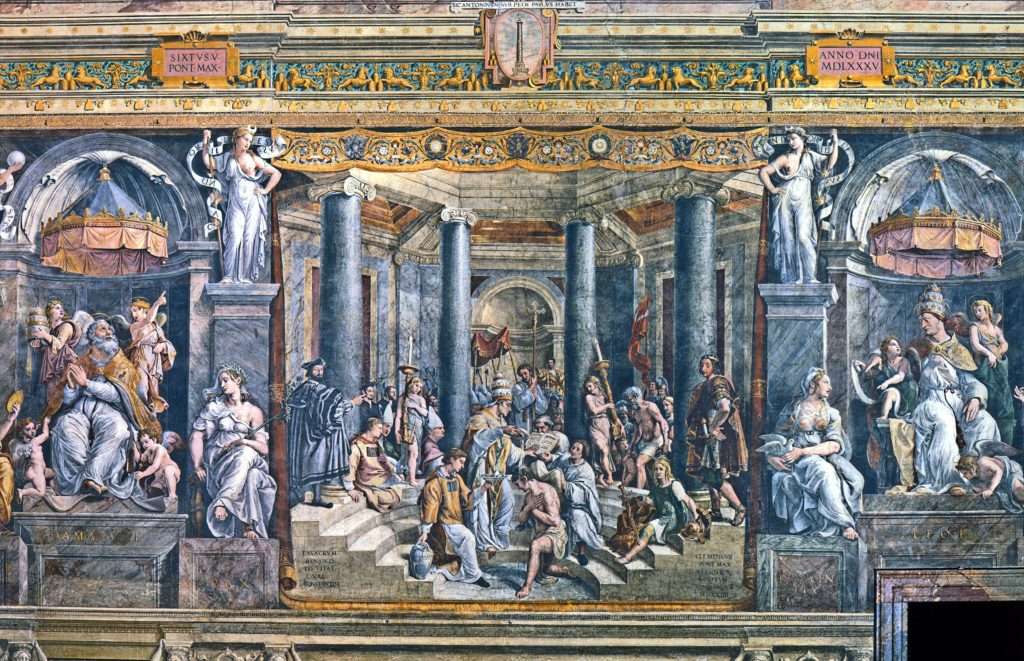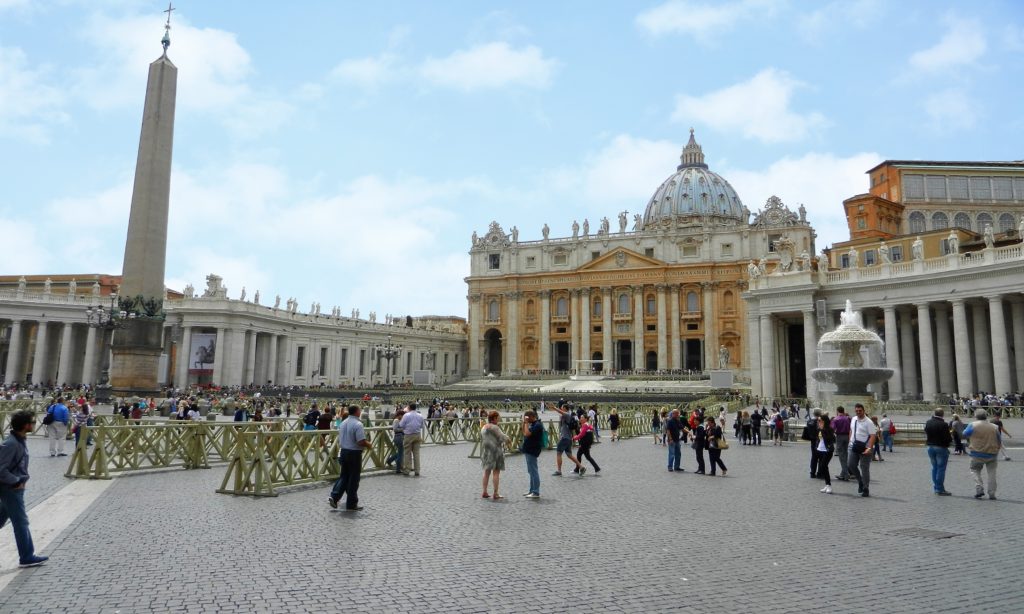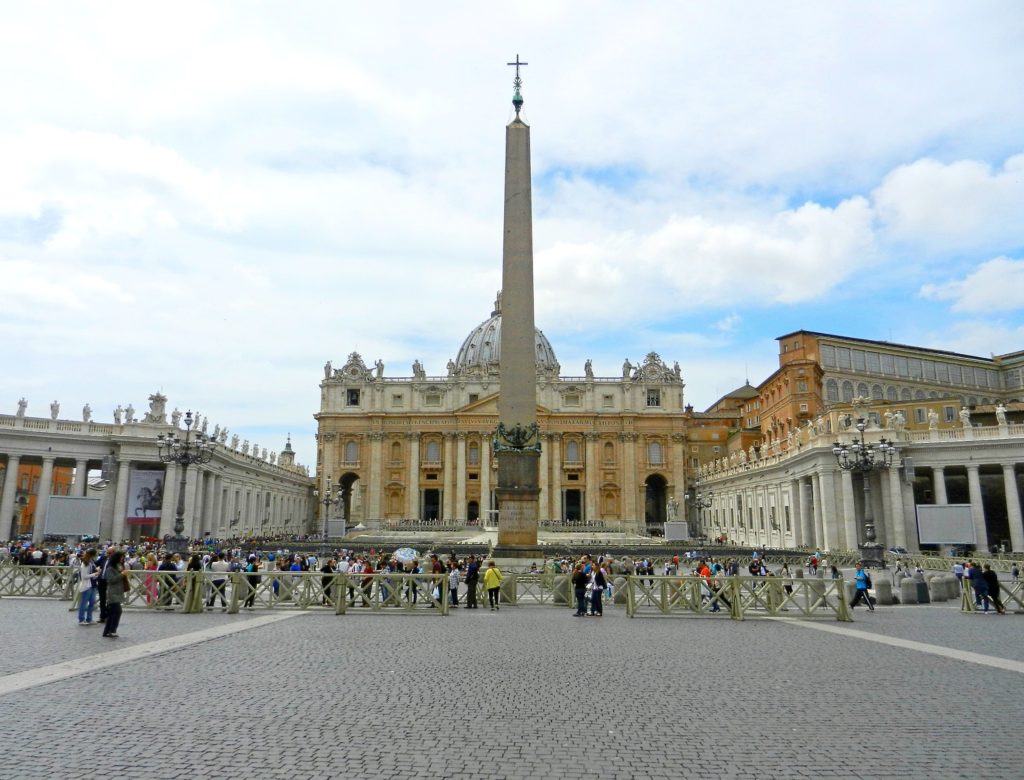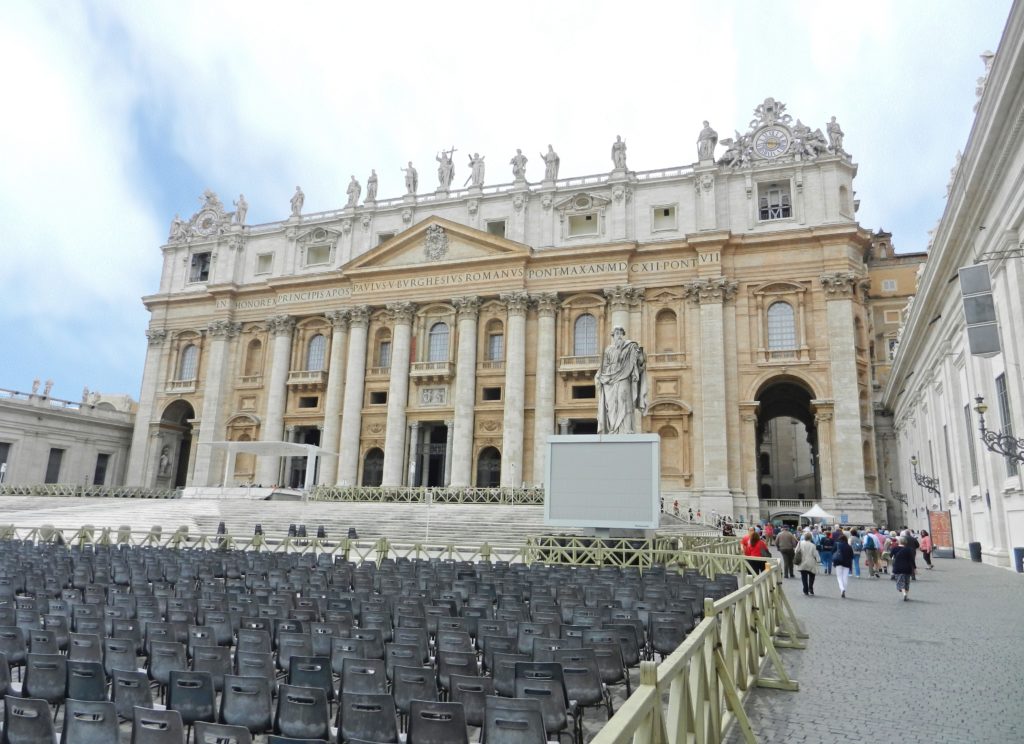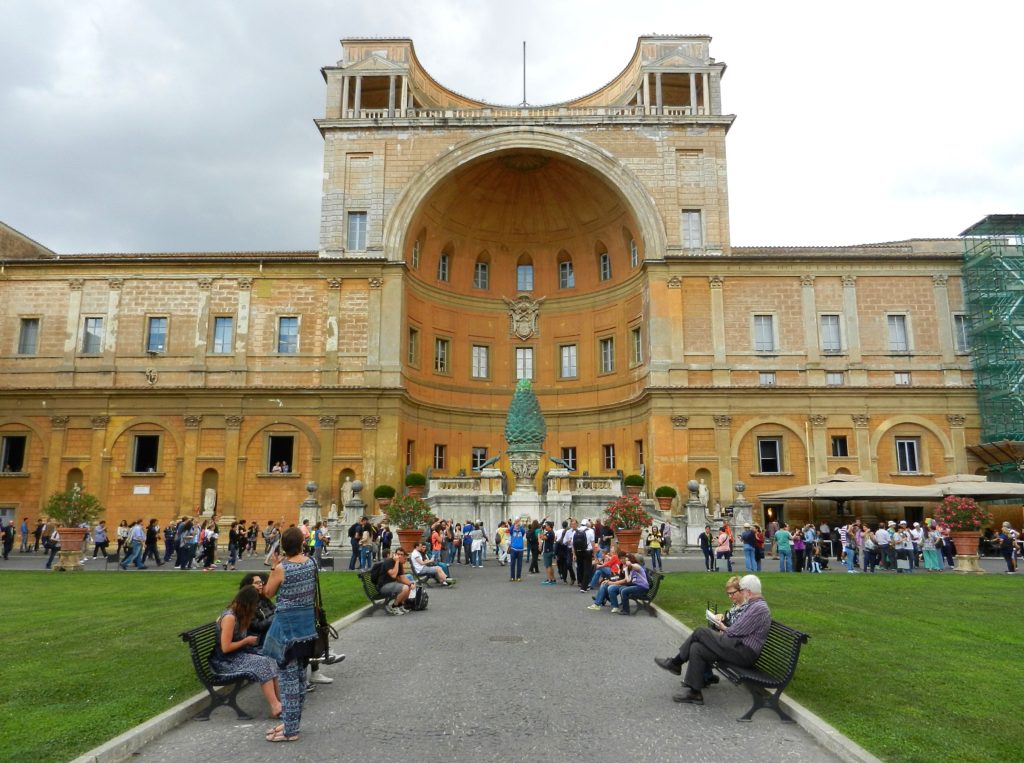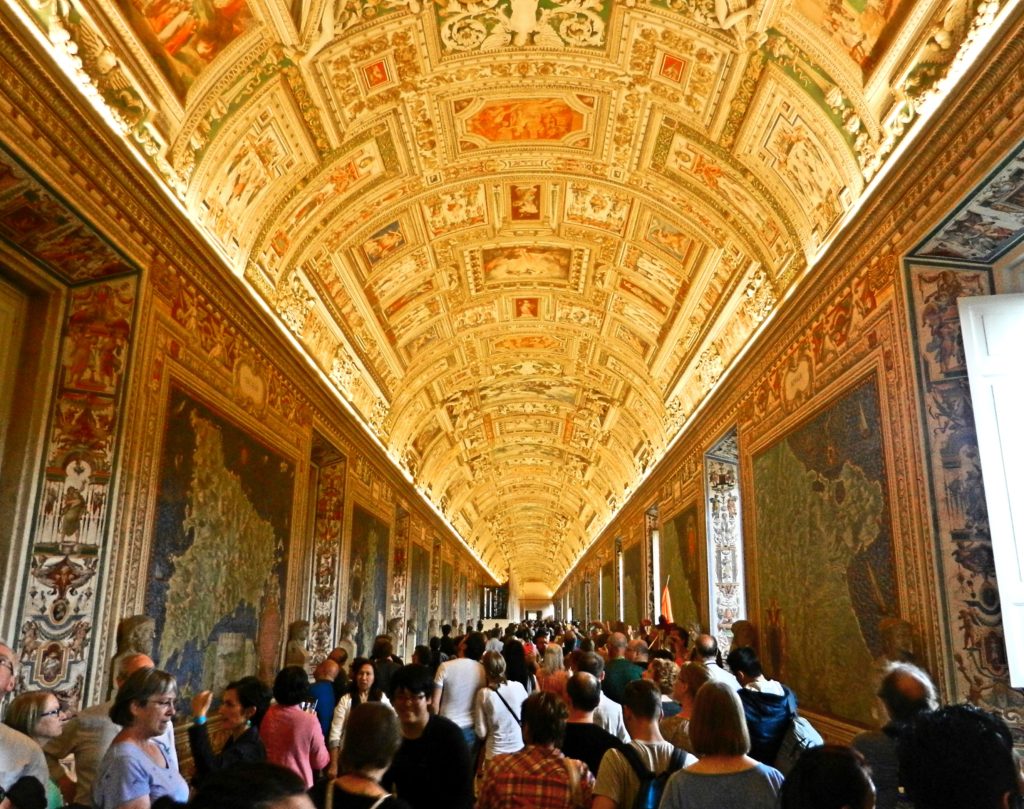You could say that the Roman Empire lives on though the Vatican. It was Emperor Constantine the Great who built the original church on Vatican hill, over the grave of Saint Peter himself. After the Western Roman Empire fell, the Catholic Church acted as the principal force of unity in the Western World. In the Middle Ages, the Pope was considered greater than all the kings and rulers of Europe. Even today, the Pope is the head of the Roman Catholic Church with more than 1.2 billion followers. Vatican City has become one of the most popular attractions in the world, drawing over 5 million tourists a year to its priceless works of art and opulent architecture. Despite one’s religious beliefs, one cannot deny the cultural and historical importance of the Roman Catholic Church and the Vatican.
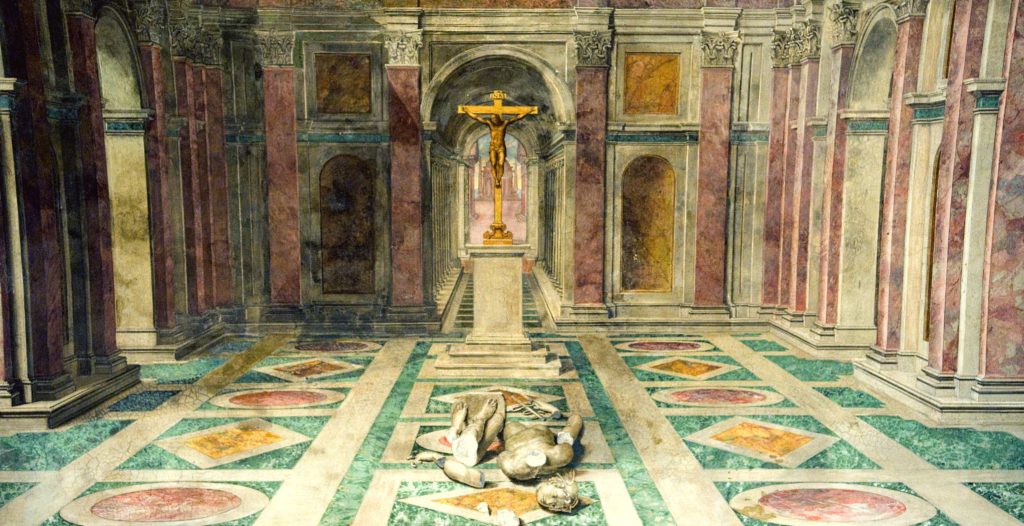
Saint Peter’s Square
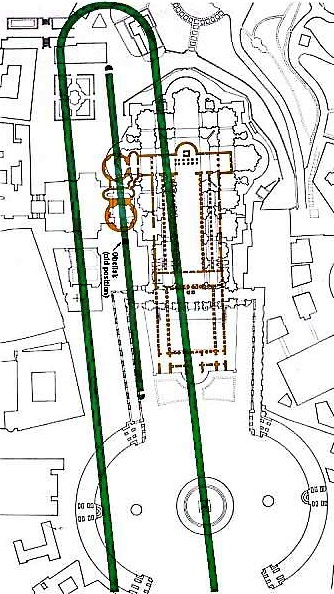
On our final day in Rome, we approached the oval St.Peter’s Square with wonder and anticipation. This is where a throng of hundreds, at the feet of Saint Peter’s Basillica, gather to listen to the Pope’s sermons. It was also the spiritual centre of the Roman Empire reborn under the new religion, Christianity. Ironically, St.Peter’s Square and Basilica were built over the Roman Circus of Nero, a state official martyrdom for Christians. From 65 AD, many Christians suffered persecution and were put to death in this arena, including Saint Peter. Legends tell us that Peter was crucified upside down because he did not deem himself worthy to die in the way of his teacher, Jesus Christ.
Because of the deaths of Saint Peter and all those Christians, Roman Emperor Constantine considered Vatican Hill as a sacred area. In 326 AD, Constantine demolished Nero’s Circus and built an enormous church on Vatican Hill, over top Peter’s grave, calling it “Saint Peter’s Church“. The only surviving remnant of Nero’s Circus is an Egyptian Obelisk, which now stands in the centre of St.Peter’s Square.
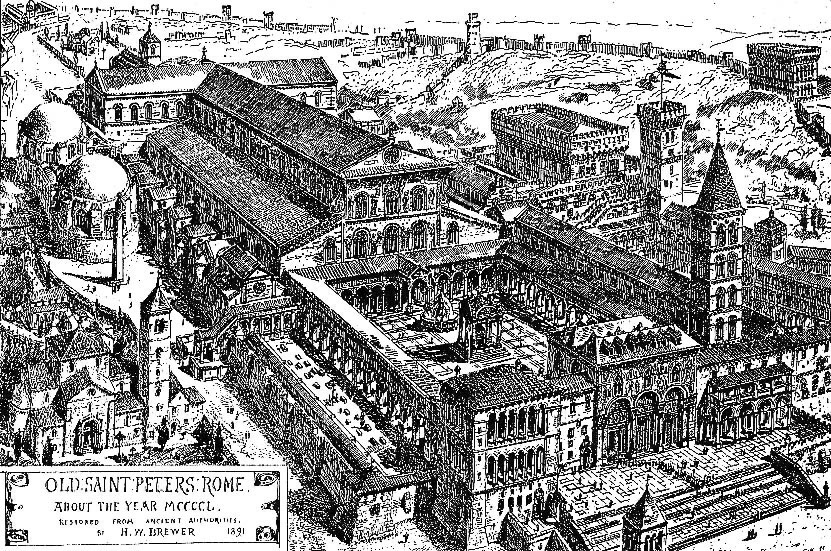
When it’s not teeming with hordes of tourists, you can really appreciate the stunning symmetry of St. Peter’s Square. Tuscan colonnades encapsulate the piazza, while twin fountains flank Nero’s Obelisk at its centre, all under the illustrious presence of St. Peter’s Basilica.
Saint Peter’s Basillica
The Constantinian Basilica of Saint Peter was demolished in 1505 to make way for the greatest church of all time. As it stands today, the “Basilica Sancti Petri” is the largest church in the world and a magnificent example of Renaissance architecture. We were temporarily scared off by the line-up, snaking into the basilica, and walked across the square to get a better look at its exterior. Without a bird’s eye view, it was difficult to visualise the true glory of Saint Peter’s Basilica due to its size, but the facade was lavishly detailed with travertine stone, Corinthian columns and statues of Jesus and the Apostles.
The basilica’s construction was pretty touch-and-go for the first 40 years. It was designed several times over by first Donato Bramante, then Giuliano da Sangallo, Fra Giocondo and Raphael. In the end it was Michelangelo who completed the bulk of the project, drawing from the plans of the previous architectural geniuses. Finalised in 1626, Saint Peter’s Basilica was a colossal structure, able to host some 60 000 people, capped with the tallest dome in the world.
After waiting a few minutes in queue (which went surprisingly quickly considering the length), we were happy to discover that the entrance to Saint Peter’s Basilica was free! Entering the Basilica was like cracking open a stupendously large geode. The exterior of the basilica is plain compared to the interior: a mighty cavern covered in baroque marble, stucco, and mosaic embellishments. Out of everything, it was the basilica’s ceiling that mesmerised me: a barrel vaulted sky of glittering, gold reliefs. Gazing up into the dome you can see God, the angels, and all the saints looking down at you from the kingdom of heaven. One thing I wish I knew when we visited: you can actually climb up into the dome and on to the roof of the Basilica, for a mere 6 euros, getting incredible views of Vatican City and St.Peter’s Square!
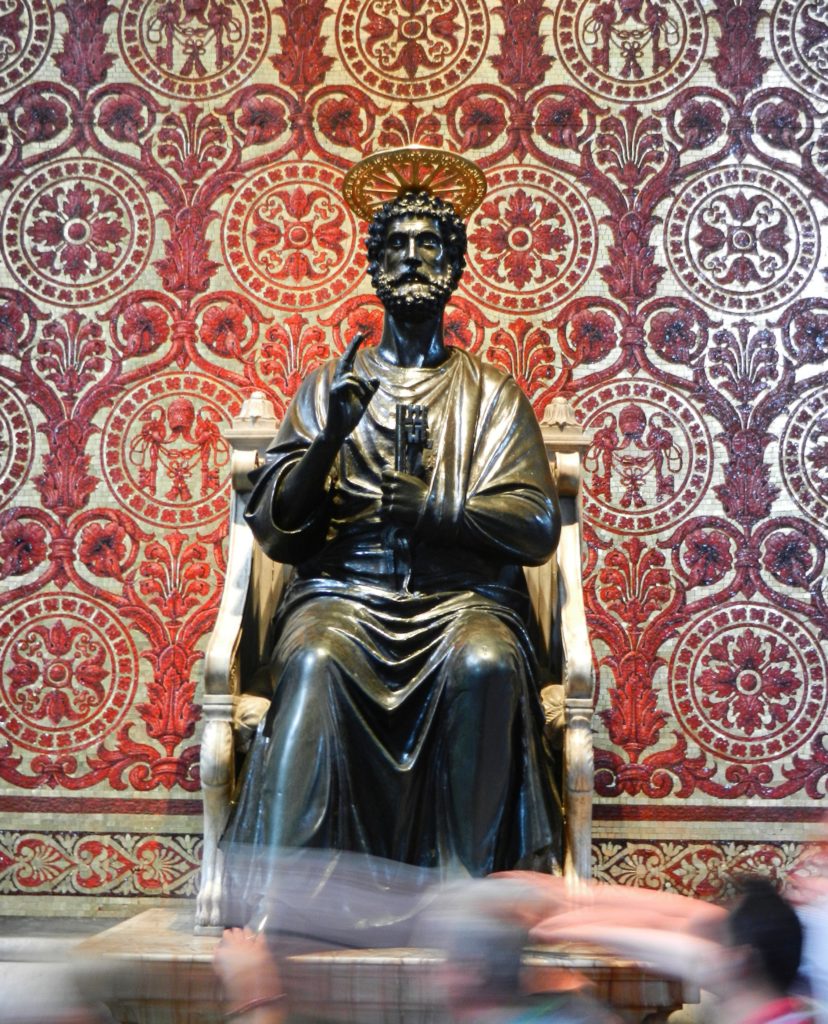
The church is filled with many statues of rulers and saints, including the enthroned statue of St. Peter. One of Peter’s feet is almost completely worn away by the amount of pilgrims and the faithful, kissing it to show their devotion. Peter is an important figure in Catholicism, considered to be the first Pope and, according to Jesus in the New Testament, the “rock” of the Christian church.
Underneath St. Peter’s Basilica is a grotto containing the tombs of emperors, kings, and previous Popes. St. Peter’s tomb, built by Constantine in the 4th century, is also located here to honour the memory of Peter. Further excavations in 1945 revealed a more ancient necropolis underneath the Basilica. It is believed that Peter’s true tomb, containing the body of a 60 year old man, was discovered there.
Vatican City
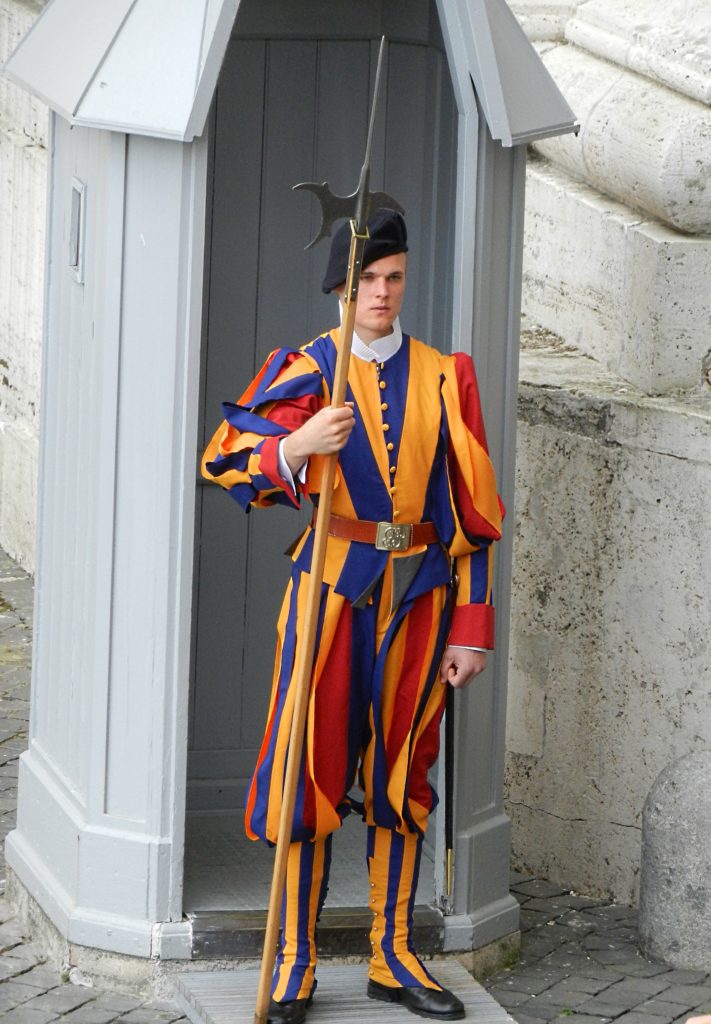
After taking a few photos of the Swiss Guard and snickering about their flashy uniforms, Ashleigh and I tried to figure out how to get into Vatican City. Walking north from St. Peter’s Piazza through Porta Angelus, we followed the city wall, hoping to find an entryway. As we walked, we marvelled at the mighty walls that once defended the Vatican at the height of its power.
At one time, the Vatican was not just a holy city but the capital of a powerful state. Walls and fortifications were built to dissuade would-be invaders, and the Vatican employed its own army. The Pope owned most of central Italy, the Papal States, and over the centuries the Vatican became extremely wealthy. Opulent churches and palaces were built and priceless treasures were amassed, providing the major tourist attractions of today’s Vatican City.
In 1860, Victor Emmanuel II stripped the Vatican of all its power and land, conquering the Papal States and uniting all of Italy. When Prime Minister Benito Mussolini signed the The Lateran Treaty in 1929, the 0.44 km2 of land within the walls of Vatican City became an independent state once again. The Vatican is currently the smallest country in the world!
Vatican Museum
At last we came upon the entrance to the Vatican Museum on Viale Vaticano. The museum is world famous for its priceless art and we were eager to lay our eyes on the treasures inside. Entry to the Vatican museums cost 16 euros and the lineup is usually pretty long, but it offers more than two dozen distinct collections with the Sistine Chapel as its climax. Before you enter the Vatican, you have to make sure to cover up those sexy legs and shoulders or the guards won’t let you in (they’re probably just jealous).
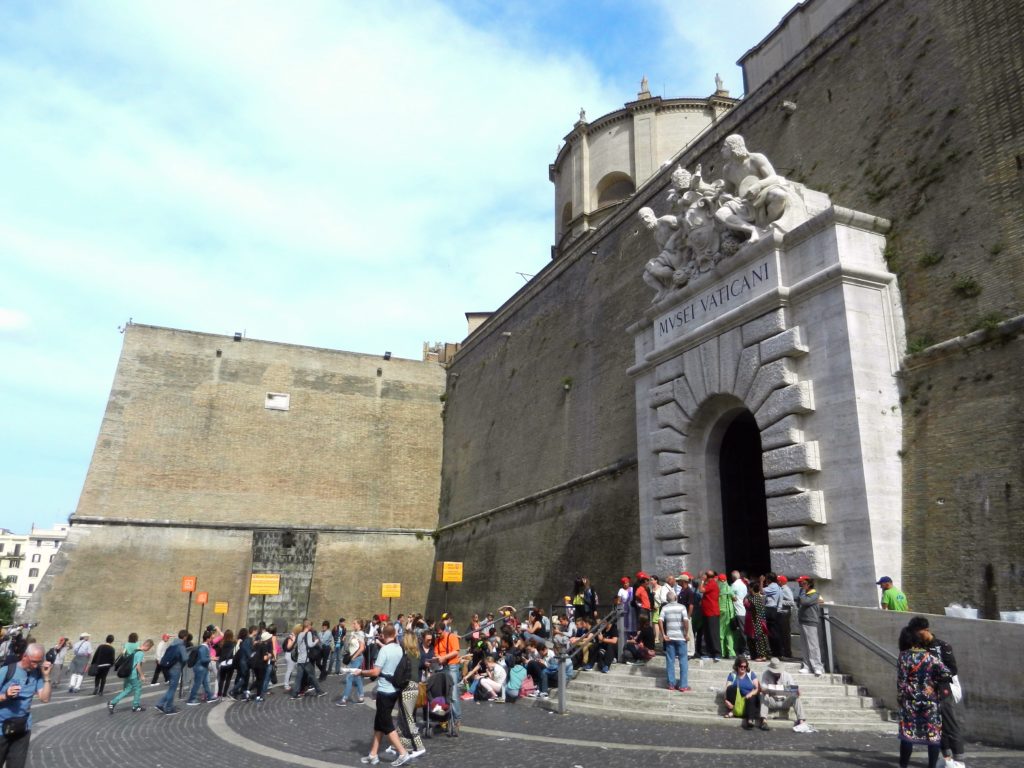
Passing through security, we climbed a spiral stairway and began our tour of the Vatican Museum. First, we explored the Pio-Clementino Museum, named after the two Popes who completed it: Clement XIV and Pius VI. Pio-Clementino’s rooms were filled with astonishingly life-like Greek and Renaissance sculptures, my favourite being the Hall of Animals. I could have spent hours in the Pio-Clementino Museum but we had barely started our tour of the Vatican and time was short.
Following the crowd, we passed through the Gregorian Egyptian Museum and out into the fresh air of Pinecone Courtyard. Named after a giant, bronze pinecone, the Cortile della Pigna was a nice place to escape the insane crowds and have lunch in the sunshine. The courtyard is a spacious, grassy area enclosed by the beautiful, papal palaces. The four-metre high pinecone on top of the Fontana della Pigna is a pre-Christian sculpture dating from the 1st century, symbolising regeneration. In the middle of Pinecone Courtyard is a hard-to-miss bronze ball, a massive, modern sculpture by Arnaldo Pomodoro. The “Sphere within a Sphere” looks like a huge, fractured, golden orb with working machinery inside. The sphere is supposed to symbolise the complexity and the fragility of our world, and is part of a collection that can be found in important locations around the globe.
Having restored our energy for more museum-ing, Ashleigh and I checked out the Chiaramonti Museum and Lapidary Gallery. The Lapidary Gallery is a “stone library” full of ancient text inscribed on stone. The gallery is usually closed to tourists, but I snapped a picture through the bars anyways. The Chiaramonti Museum is a long hallway filled with yet more Greek and Roman sculptures. I had fun trying to figure out which gods and emperors they were before I gave up and we climbed to the second floor.
On the floor above Pio-Clementino is the Gregorian Etruscan Museum displaying priceless artefacts from ancient Etruria. The Etruscan civilisation existed between 768 and 264 BC, before they were assimilated into the Roman Republic in the late 4th century. The museum holds eight galleries of Etruscan vases, sarcophagi, and bronze relics from antiquity.
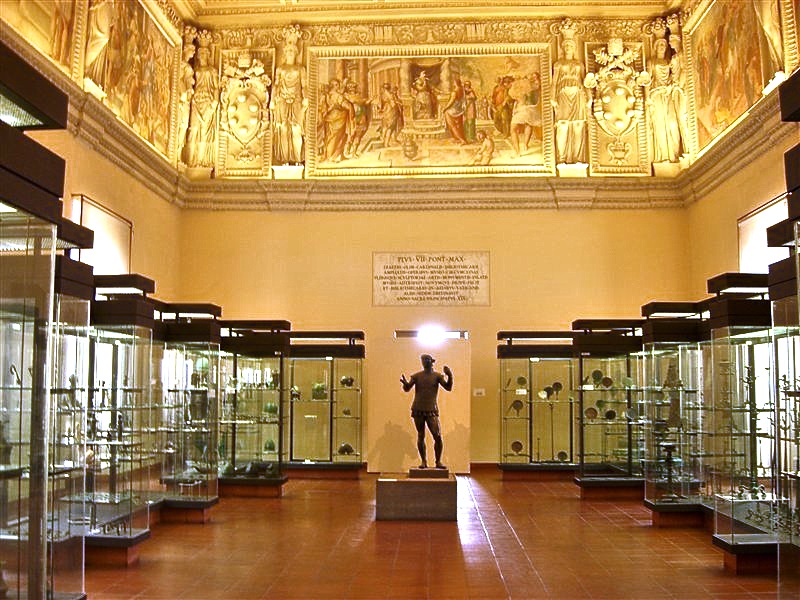
Climbing up to the third floor, we crossed the Gallery of Arazzi, covered with detailed, Flemish tapestries from the 1600s, and came to the Map Gallery. I really enjoyed studying these hand painted, Renaissance maps, covering every inch of the gallery’s wall space. Painted during the time of Pope Gregory XIII between 1580 and 1585, these maps represent Italian regions and papal properties. I was also amazed by the splendid stucco decorations and religious paintings that adorned the gallery’s arched ceiling.
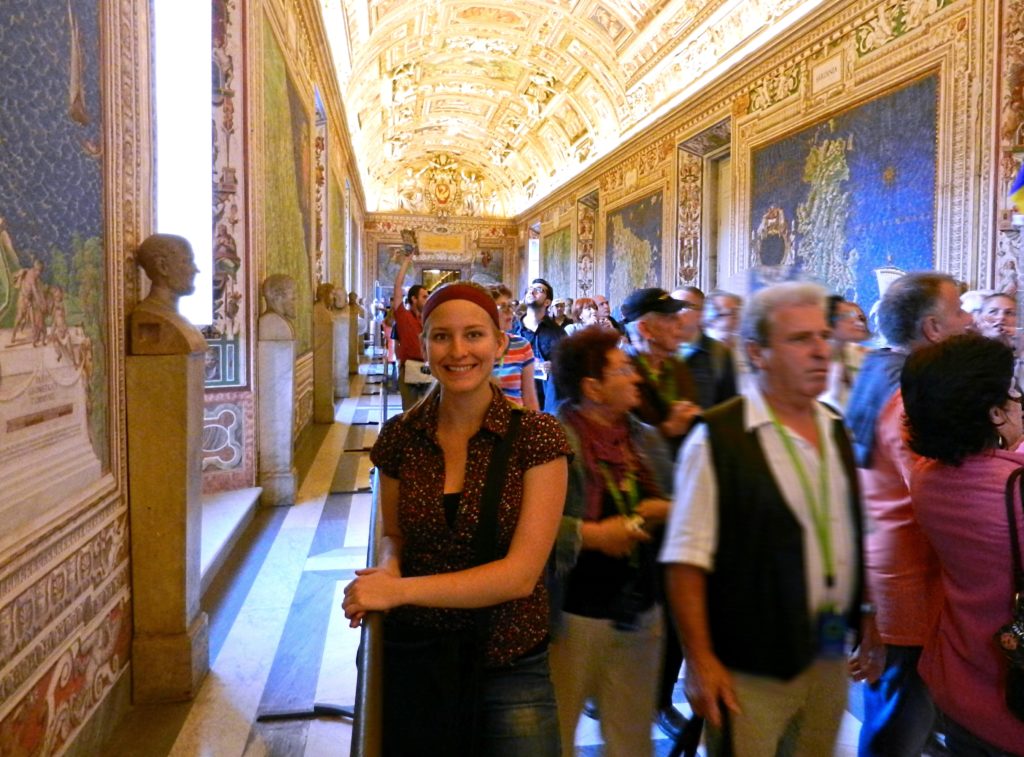
Ashleigh and I were already tired, but there were still more fabulous works of art to see. Next were the resplendent Renaissance paintings of the Raphael Rooms, Nicoline Chapel and the Room of the Immaculate Conception. The walls and ceilings of these galleries depicted colourful pictures from history and legend. We spent hours gazing into paintings of chaotic battles and celestial scenes, each muscle, shadow and distant background displayed in remarkable detail.
Sistine Chapel
On our long but glorious journey through the Vatican Museum, I felt like each room grew steadily more beautiful leading to the Sistine Chapel— the climax of artistic ingenuity. As we entered this special room, we walked into a large crowd of tourists glancing around in awe and almost complete silence. The magnificent frescoes painted on the walls of the Sistine Chapel are essentially an illustrated version of the Holy Bible, depicting scenes from the creation of the world to Judgement Day. “The Last Judgement” is the most famous fresco in Sistine Chapel, painted by Michelangelo on the altar wall. The mural depicts the return of Jesus Christ to take the righteous to heaven and the final judgement by God of all humanity. Another iconic image by Michelangelo is “The Creation of Adam” on the chapel ceiling, showing God reaching out to man. If you can’t visit the Sistine Chapel in person, the next best thing is to take a “virtual tour” on the Vatican Museum’s website.
The Papal Conclave has been a procedure for selecting the next Pope for almost a thousand years. Since 1492, the election of a new Pope has been decided within the Sistine Chapel. The College of Cardinals lock themselves inside the Sistine Chapel until a unanimous decision is made. After each vote, if a new Pope was not elected, damp straw would be burnt in a stove to produce black smoke. The public would carefully watch the chimney of the Sistine Chapel while the election took place. When a Pope was finally chosen, the Cardinals burnt the paper ballots to produce white smoke. In the past, this form of smoke signalling wasn’t entirely clear. For the 2005 conclave, a new stove was installed which held separate canisters of certain chemicals that would create more distinct colours. The stove was so complicated, however, that nobody knew how to operate it. Smoke started billowing into the Sistine Chapel, covering Michelangelo’s ceiling frescoes which had been just recently restored.
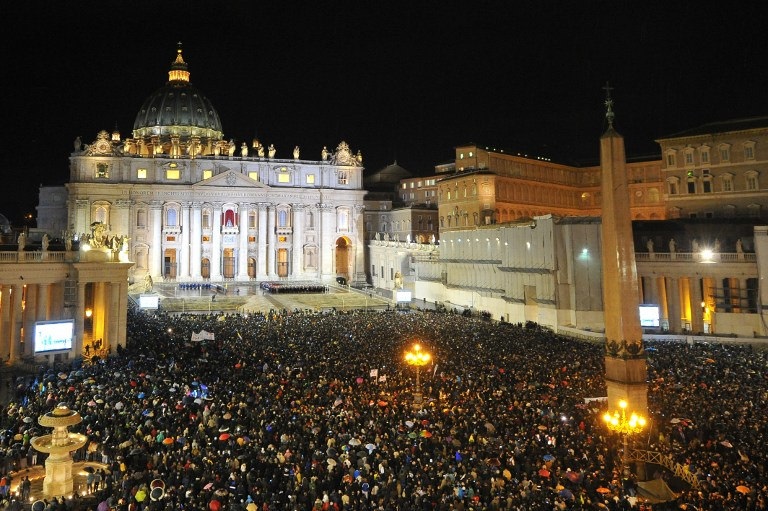
Conclusion
The treasures and monuments assembled by the Vatican over the centuries are amazing to witness. But more important than their treasures is the strong influence the Vatican, and Catholicism in general, has had on western culture. By using the vehicle of the Roman Empire, the Catholic Church became a ruling force in Europe and eventually the Americas. What westerners now accept as their culture were once rules and regulations developed by the Pope and his Cardinals. For example, history is organised either before or after the crucifixion of Jesus Christ (B.C. stands for “Before Christ” and A.D. means “Anno Domini”, in the year of the Lord). The Gregorian Calendar, used by most of the world today, was developed by Pope Gregory XIII. Popular festivals like Christmas and Easter are important Christian holidays. The Catholic Church has been responsible for founding most of the original universities and academic institutions. The laws and philosophies of western society are drawn from Christian values, the teachings of Jesus in the New Testament. From Emperor Constantine to the succeeding Popes of the Vatican, the mantle of Christianity and Catholicism has been passed on to the modern age. Despite one’s religious beliefs, Christianity roots deeply in the cultural mind of Europe and the Americas.
